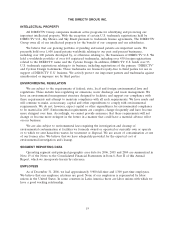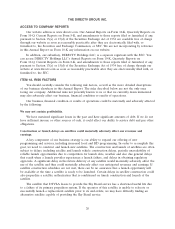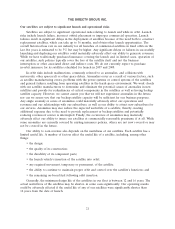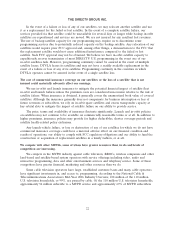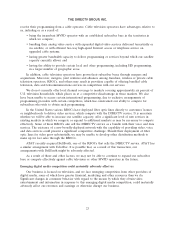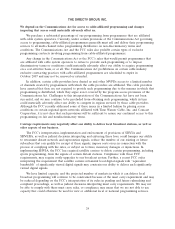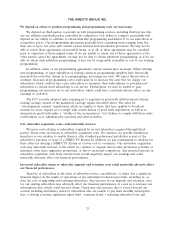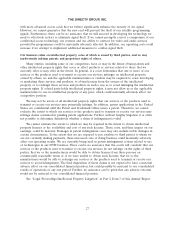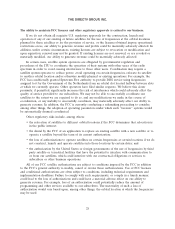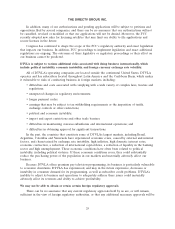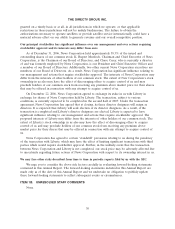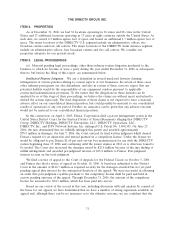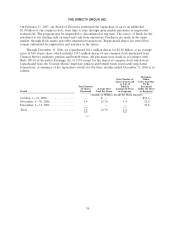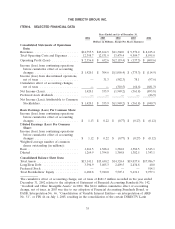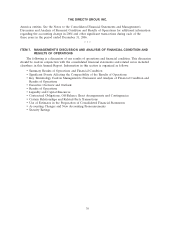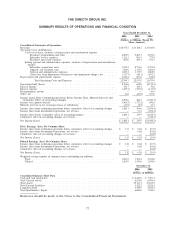DIRECTV 2006 Annual Report Download - page 38
Download and view the complete annual report
Please find page 38 of the 2006 DIRECTV annual report below. You can navigate through the pages in the report by either clicking on the pages listed below, or by using the keyword search tool below to find specific information within the annual report.THE DIRECTV GROUP, INC.
with more advanced access cards that we believe significantly enhance the security of our signal.
However, we cannot guarantee that the new card will prevent the theft of our satellite programming
signals. Furthermore, there can be no assurance that we will succeed in developing the technology we
need to effectively restrict or eliminate signal theft. If we cannot promptly correct a compromise of our
conditional access technology, our revenue and our ability to contract for video and audio services
provided by programmers could be materially adversely affected. In addition, our operating costs could
increase if we attempt to implement additional measures to combat signal theft.
Our business relies on intellectual property, some of which is owned by third parties, and we may
inadvertently infringe patents and proprietary rights of others.
Many entities, including some of our competitors, have or may in the future obtain patents and
other intellectual property rights that cover or affect products or services related to those that we
currently offer or may offer in the future. In general, if a court determines that one or more of our
services or the products used to transmit or receive our services infringes on intellectual property
owned by others, we and the applicable manufacturers or vendors may be required to cease developing
or marketing those services and products, to obtain licenses from the owners of the intellectual
property or to redesign those services and products in such a way as to avoid infringing the intellectual
property rights. If a third party holds intellectual property rights, it may not allow us or the applicable
manufacturers to use its intellectual property at any price, which could materially adversely affect our
competitive position.
We may not be aware of all intellectual property rights that our services or the products used to
transmit or receive our services may potentially infringe. In addition, patent applications in the United
States are confidential until the Patent and Trademark Office issues a patent. Therefore, we cannot
evaluate the extent to which our services or the products used to transmit or receive our services may
infringe claims contained in pending patent applications. Further, without lengthy litigation, it is often
not possible to determine definitively whether a claim of infringement is valid.
We cannot estimate the extent to which we may be required in the future to obtain intellectual
property licenses or the availability and cost of any such licenses. Those costs, and their impact on our
earnings, could be material. Damages in patent infringement cases may also include treble damages in
certain circumstances. To the extent that we are required to pay royalties to third parties to whom we
are not currently making payments, these increased costs of doing business could materially adversely
affect our operating results. We are currently being sued in patent infringement actions related to use
of technologies in our DTH business. There can be no assurance that the courts will conclude that our
services or the products used to transmit or receive our services do not infringe on the rights of third
parties, that we or the manufacturers would be able to obtain licenses from these persons on
commercially reasonable terms or, if we were unable to obtain such licenses, that we or the
manufacturers would be able to redesign our services or the products used to transmit or receive our
services to avoid infringement. The final disposition of these claims is not expected to have a material
adverse effect on our consolidated financial position, but could possibly be material to our consolidated
results of operations of any one period. Further, no assurance can be given that any adverse outcome
would not be material to our consolidated financial position.
See ‘‘Legal Proceedings-Intellectual Property Litigation’’ in Part I, Item 3 of this Annual Report.
27




